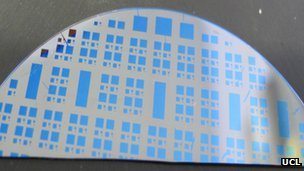Memristors in silicon promising for dense and fast memory
Peter Donnell / 12 years ago

The device is a “memristor”, a long-hypothesised but only recently demonstrated electronic component. A memristor’s electronic properties make it suitable for both for computing and for far faster, denser memory.
Researchers at the European Materials Research Society meeting now say it can be made much more cheaply, using current semiconductor techniques. There has been significant interest in memristors since the first prototype was unveiled in 2008, not least because it took 37 years for the device to make it from theoretical proposition to reality. The name is a portmanteau of memory and resistor, because its resistance changes depending on how much current has passed through it; it “remembers” that value even after power is turned off.
The history-dependent nature of their electrical properties would make them able to carry out calculations, but most interest has focused on developing them for memory applications, to replace the widespread “flash” solid-state memory of USB sticks and memory cards.
“We’re reaching the limits of what we can do with flash memory in terms of increasing the storage density, and it’s also relatively high power and not as fast as we would like,” said Anthony Kenyon of University College London, UK.
However, researchers are still working to get memristor devices out of the laboratory and into consumer electronics. Hewlett-Packard, whose engineers demonstrated the first working memristor, already have plans to bring early memristor designs to market.

Current designs employ expensive or exotic materials, but a real memristor revolution could hinge on making them compatible with existing semiconductor technology, based overwhelmingly on silicon. Such attempts have been made before, but previous devices reported in a 2010 paper in Nano Letters were fairly delicate and worked only under vacuum. Now, Dr Kenyon, his student Adnan Mehonic, and his colleagues from UCL, France and Spain have stumbled across a better way to make silicon memristors. The team was working on silicon devices for LEDs when they accidentally discovered that a film of silicon oxide on their devices – which forms naturally when silicon is left out in air – behaved as memristors.
Mr Mehonic went on to study just what was going on inside the films, and the team recently published details of their findings in the Journal of Applied Physics. What they have found is that their devices appear to significantly outperform existing solid-state “flash” memory. As they described at this week’s conference, the energy required to switch the state of their devices – the energy it would take to store or retrieve a bit of information – is just a hundredth of that in existing flash memory, and significantly faster.
“Flash memory devices switch at 10,000 nanoseconds (billionths of a second) or so, and in our device we can’t measure how fast it is,” Dr Kenyon said. “Our equipment only goes down to 90 nanoseconds. It’s at least as fast as that and probably faster.”
Though the team’s idea is a bit behind other more well developed memristor recipes, Dr Kenyon is hopeful the cheap and simple nature of their devices will make them industrially attractive.
“Discussions are at a early stage but we are talking to some fairly major names in the industry about taking this and commercialising it,” he said.
Source: BBC News



















